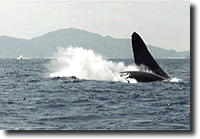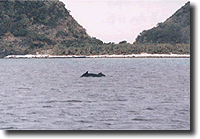Stories by Zamami Village Whale Watching Association
|
|||
| Mating Pods
In order to win females to pair up with as mates, male whales engage in repeated fierce battles amongst themselves. At certain times as many as two to eight males will accompany one female. The male humpbacks do this to propagate their species and for them it is serious business, but for whale-watchers it is a chance to have an unforgettable experience viewing this dramatic behavior. The seas off Zamami Island are mating seas for the humpback and in contrast to other sea areas, such as feeding seas where such behavior as bubble net fishing can be seen, the Zamami seas are where visitors can come to watch their mating pod behavior. Every year, around February, the number of mating pods increases and battles for mates occur repeatedly in many locations. Whale-watchers can observe breaching and lobtailing as well as comparatively rarer behavior such as sticking their heads out of the water with their mouths open wide, inflating the lower portion of their jaws and rushing through the water, swimming sideways and ramming each other. If this is what is happening on the surface of the water, you can imagine the activity below. When the males group in such way, some of the battles last over two days until a victor finally emerges. |
|||
 |
A Meeting with Tacchan
About five or six years ago one whale showed great curiosity for the whale-watching boats and was named Tacchan. This year, on the morning of January 11, 2000, everyone was out on the whale-watching platform looking for the appearance of whales. Finally after two hours they were spotted and the captain of the boat yelled out "Here we go!" and set sail. About twenty minutes later we saw two blows! When I saw the tail I knew it was Tacchan. What excitement! But when I looked closer, it was really another whale entirely! Then, as if in a dream, I saw Tacchan slapping the water a number of times right directly in front of the boat. Tacchan wasn't diving very deep and we could see her swimming, jutting her face out of the water, and rolling on her chest, waving her flipper as if she wanted to take our hands. "Tacchan! Show us your face." Everyone was delighted. Another whale surfaced occasionally, exhaling a huge rainbow colored blow. One of the two breached magnificently. One of the women with us saw a whale breach for the first time and shed tears of excitement. I hope we can see them play like that again. |
||
 |
The Breeding Waters Off Zamami
For the Humpback, the breeding areas are far away from their normal fishing grounds. To breed they must travel a great distance, thousands of kilometers, and they make this migration annually. The ocean off Zamami has become their breeding sea, so whale-watchers can view pairs of whales and mother whales with young calves here. At times a mother and a youngster will have another male as escort. In the past few years over five different families have been identified. And perhaps as may as ten whales have been born in these waters. While there have been numerous sightings of calves milking, it is unfortunate that no one has been able to see the births of these beautiful mammals. When the seas get rough, many sightings have been confirmed around Akajima, as the mothers and their calves move to comparatively calmer water. |
||
